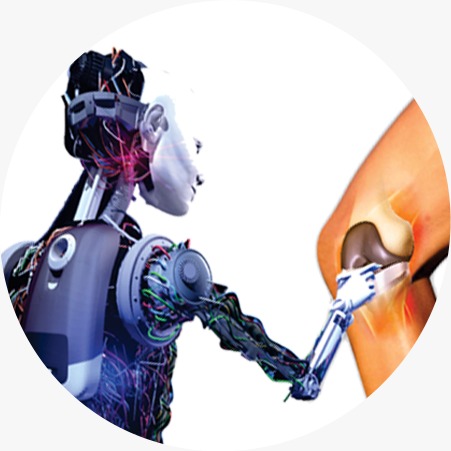
Knee replacement, also called knee arthroplasty, is a surgical procedure to resurface a knee damaged by arthritis. Metal and plastic parts are used to cap the ends of the bones that form the knee joint, along with the kneecap. This surgery may be considered for someone who has severe arthritis or severe knee damage. If the patient quality of life is deteriorated due to pain or when other conservative measures failed.
Various types of arthritis may affect the knee joint. Osteoarthritis, a degenerative joint disease that affects mostly middle-aged and older adults, may cause the breakdown of joint cartilage and adjacent bone in the knees. Rheumatoid arthritis, which causes inflammation of the synovial membrane and results in excessive synovial fluid, can lead to pain and stiffness. Traumatic arthritis, arthritis due to injury, may cause damage to the cartilage of the knee.







Total Knee Replacement(TKR) has been a time-consuming procedure with close to 3 hours of surgery and considerable hospital stay post-surgery. However, recent years have witnessed a growing trend in Daycare, Fast Track Total Knee Replacement procedures for ideal patient candidates.
Fast Track TKR is a sophisticated procedure currently performed only a few centers that have the necessary infrastructure and an expert team. With this new revolutionary minimally invasive technique at Indore, TKR surgery can be completed in just one hour with a cost reduction by close to 20 % along with reduced chances of infection.
The Daycare TKR procedure involves using advanced surgical techniques performed with miniature instruments while administering regional anaesthesia limited to the leg area. The miniature instruments used in the procedure ensure minimal cuts (incision), that together with regional anesthesia significantly reduces pain, trauma, infections, complications, and side effects usually associated with surgery, besides helping in faster recovery of the patient.
With minimal incision, minimal exposure, minimal blood loss, and shorter hospital stay, Fast Track TKR have revolutionized the healthcare industry. Daycare fast-track TKR also brings down the total expenditure or cost of surgery by approximately 20% compared to standard TKRs. However, choosing the right patient with no comorbidities is crucial. Some of the benefits of Daycare, Fast Track TKR include:
1. Faster recovery
2. No overnight stay in the hospital
3. Minimum or no disturbance to the regular routine
4. Economic advantages (Up to 20%)
5. Minimal pain owing to unique anesthesia methods
6. Faster mobility
7. Faster return to normalcy
8. Less mental stress or disturbances (especially in the elderly)
9. Reduced risk of cross-infection at hospitals to the patients and their relatives (especially during the COVID-19 pandemic)